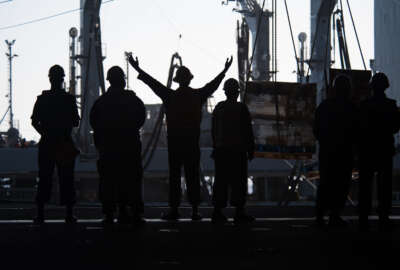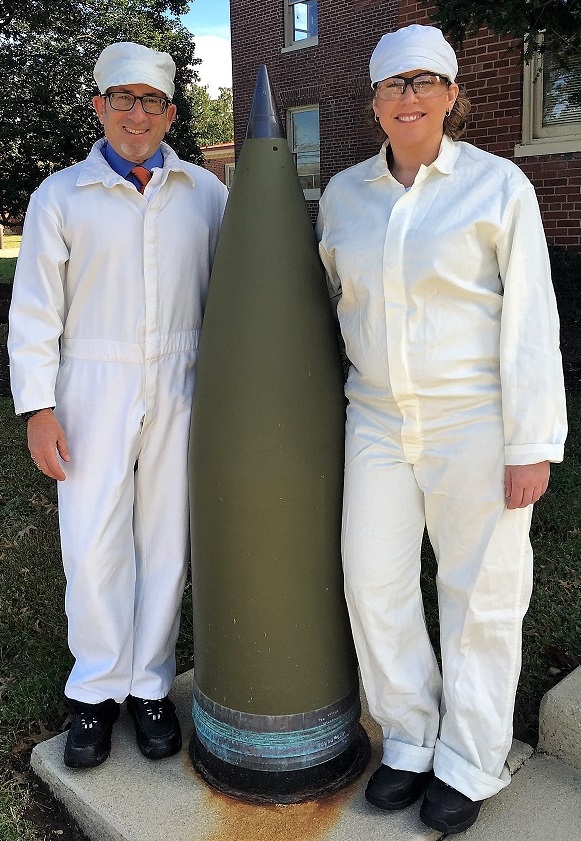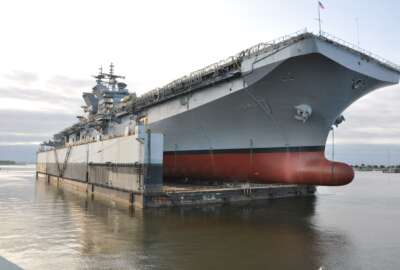
Navy’s own ‘red wheelbarrow glazed with rain’
Down the end of a narrow, wooded road, on a sparsely populated peninsula, little-known feds help sharpen the tooth for U.S. warfighters
Best listening experience is on Chrome, Firefox or Safari. Subscribe to Federal Drive’s daily audio interviews on Apple Podcasts or PodcastOne.
Pushing foam earplugs into my ears, standing outside of a small shed made of thick steel I braced myself. “Whhoomph!” goes the blast inside. Technicians opened the door and a thin smoke spilled out. A dummy payload, about a yard long and shaped like a bomb, had dropped from a rack into a sand pit on the floor.
I had just ear-witnessed a test of two explosive charges, each the size of a small pill bottle. They successfully detonated, their resulting gases forcing open the jaws on a warplane bomb rack. The “bomb” successfully released.

The demonstration was one of hundreds of year-round tests at the Naval Surface Warfare Center Indian Head Explosive Ordnance Disposal Technology Division. It’s part of the Naval Sea Systems Command. Indian Head, named for the peninsula on which it sits, is a remarkably nondescript installation along the Potomac River in Maryland about 25 miles south of the busy Woodrow Wilson Bridge, and seemingly light years from the Navy Yard.
Since 1890, Indian Head’s mission is to “provide research, development, engineering, manufacturing, test, evaluation and in-service support” of military energetics, or materials which go boom.
The shed where I and Federal Drive with Tom Temin producer Lauren Larson heard what amounted to a pair of cherry bombs going off was one in a row of about a dozen. Other sheds contained test facilities for different types of charges, and some house electronic benches for evaluating circuitry.
U.S. warplanes use similar charges, called cartridge actuated devices, to power ejection seats. Rob Beagley, the division chief for test and evaluation at Indian Head, said pilots have come by to tour the place. He said flyers who have had to use ejection seats thanked him and the staff there, saying, “I was able to go home to my family.”
Clad in the heavy canvas jumpsuits required of all visitors at the labs and testbeds at Indian Head, I listened to Beagley describe the range of activities under his watch. He was joined by Patrick Proctor, an engineering technician, and Jean Clotaire, a mechanical engineer. Their expertise, devotion to safety and seriousness about the ultimate mission were obvious. Beagley is aware the place isn’t much to look at, and that a few cosmetic and creature-comfort upgrades wouldn’t hurt, such as a fresh coat of paint. The walkway, sheltered with faded butterfly fiber glass, is littered with rusting chairs and battered steel tables.
But like other people I’ve known who are totally focused on their work, they don’t fuss much about physical plant aesthetics. Pointing to a bent work table outside the sheds with plywood poking through torn stainless steel cladding, I asked him what condition of table would justify a requisition for a new one. “I guess worse than that,” he quipped.
“This,” I thought, looking around at the rustic site, “is where the the United States Navy evaluates the effectiveness of critical components in its lethality chain?” The familiar William Carlos Williams poem came to mind:
so much depends
upon
a red wheel
barrow
glazed with rain
water
beside the white
chickens
Staff enthusiasm runs deep
In contrast to the homeliness of the Indian Head installation is the knowledge, intensity and enthusiasm of its staff, which runs from the test techs up to the commander, Capt. Scott Kraft. Watching films of US firepower in zones of conflict, your mind might not envision a rusty shed deep in a wooded base at the end of a highway seemingly to nowhere. But it’s people such as Beagley and his crew, working day after day behind two security checkpoints, who ensure the right things happen when troops are engaged in life-or-death operations to protect the nation.

Indian Head techs subject the devices to extreme temperature cycling, salt spray, humidity and vibration, such they’ll encounter on a carrier plane. That’s just one in a range of activities having to do with anything that explodes for the military.
For safety, the buildings at Indian Head are widely spaced throughout the 1,700-acre campus. We stood a mile away inside a two-story building of thick concrete. The upper floor houses containers of ingredients used to make large quantities of energetics. On the bottom is what looks like the world’s largest Mixmaster. The bowl could nearly swallow a small car. The mixing blades each look to be four feet long to make the goo used for rocket propellants and explosive charges. Imagine making 420 gallons of that at once — it would only take one spark.
But Stuart Richman, the engineering and processing branch manager, explained that mixing operators work by remote control from another bunker. No one is inside the building when the various chemicals are blended to make the energetics order of the day. If the temperature or pressure starts to rise in the 7,000-pound bowl, it will pop open and water from the Potomac River will gush all over the place, quenching the explosion. Richman said it’s never happened but they test it periodically.
The place is old and dusty, but if you look carefully the wiring is fresh. The sensors are new and polished, the mixing blades shine and the he inside of the bowl is spotless. Quantities are large, but so is the level of precision. Like pastry chefs obsessing over croissants, Richman and his colleagues measure everything to the ounce, lest a batch of missiles not perform as expected. They don’t give out the recipe, so you can’t try this on your own KitchenAid. Yet the room contains hardware store grade scrapers, brooms, screwdrivers and rubber mallets for cleaning, maintaining, and making sure powdered chemicals all drop out of their bins and into the bowl.
Similar facilities are used throughout the explosives industry. Some supply comes from contractors and other industries, such as mining and demolition, also use explosives. Military-grade energetics, though, demand much narrower tolerances. Indian Head is where the details are worked out, the knowledge maintained.
You don’t need a fancy building or a shiny shed to test energetics. Indian Head facilities remind me of my neighbor’s 1962 Cadillac convertible. The body is blackish with a patina of rust. It lacks carpets, interior door panels, or a back seat. Wires run everywhere through holes in the bare chassis. There’s no hood. But because he’s a master mechanic the giant engine and various other mechanical components form a finely tuned speedster. The Max Mad-looking hulk is actually fast and precise.
A good farmer may not care if his wheelbarrow is “glazed with rain water.” But he’ll keep the tire inflated and the bearings lubed. That’s what matters. So it is at Indian Head. So much depends on it.
Copyright © 2025 Federal News Network. All rights reserved. This website is not intended for users located within the European Economic Area.
Tom Temin is host of the Federal Drive and has been providing insight on federal technology and management issues for more than 30 years.
Follow @tteminWFED






